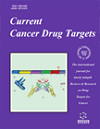- Home
- A-Z Publications
- Current Cancer Drug Targets
- Previous Issues
- Volume 22, Issue 11, 2022
Current Cancer Drug Targets - Volume 22, Issue 11, 2022
Volume 22, Issue 11, 2022
-
-
Resistance of Lenvatinib in Hepatocellular Carcinoma
More LessAuthors: Jinhui Guo, Junjun Zhao, Qiuran Xu and Dongsheng HuangLenvatinib is a multikinase inhibitor which mainly hinders liver cancer proliferation by inhibiting angiogenesis. In 2018, Lenvatinib was approved for the first-line treatment of patients with advanced hepatocellular carcinoma [HCC] in the United States, the European Union, Japan, and China. Lenvatinib has been established as a sorafenib replacement drug with a higher objective response rate [ORR], longer progression-free s Read More
-
-
-
Assessing Long Non-coding RNAs in Tobacco-associated Oral Cancer
More LessAuthors: Manish K. Mishra, Sachin Gupta, Shivangi and Shelly SehgalCancer is one of the compelling and pegged diseases battled by clinicians and researchers worldwide. Among different types of cancer, oral cancer holds the sixth position globally. With an escalating prevalence in Asian countries, India, China, and Pakistan constitute a large proportion of total incidents of oral cancer patients in terms of new cases or deaths. This mounting prevalence is ascribed to poor oral hygiene and rampa Read More
-
-
-
Saikosaponin B4 Suppression Cancer Progression by Inhibiting SW480 and SW620 Cells Proliferation via the PI3K/AKT/mTOR Pathway in Colon Cancer
More LessAuthors: Yiwei Zhang, Lizhen Lin, Yushu Wang, Zhenzhen Liu, Wenxin Xia, Hong Sui and Xueyan FuBackground: Colon cancer is a gastrointestinal malignancy with high incidence and poor prognosis. Objective: Saikosaponin B4 (SSB4) is a monomeric component of the Traditional Chinese medicine (TCM), Bupleurum. The current study investigates the therapeutic effect and mechanisms of SSB4 in colon cancer. Methods: The proliferation of two colon cancer cell lines, SW480 and SW620, were assessed using Read More
-
-
-
Dextran Sulfate Inhibits Angiogenesis and Invasion of Gastric Cancer by Interfering with M2-type Macrophages Polarization
More LessAuthors: Jiaxin Guo, Zhaojun Li, Qian Ma, Mengqi Li, Yuan Zhao, Bing Li, Yuejia Tao, Yuanyi Xu and Yunning HuangPurpose: To explore the effect of dextran sulfate (DS) on the angiogenesis, invasion, and migration of gastric cancer cells by interfering with the polarization of M2-type macrophages. Methods: The infiltration of M2-type macrophages and microvascular density in gastric cancer and paracancerous tissues were analyzed using immunohistochemistry and immunofluorescence. The effects of DS on M2-type macrophage Read More
-
-
-
BCL11A Facilitates Cell Proliferation and Metastasis in Neuroblastoma via Regulating the PI3K/Akt Signaling Pathway
More LessAuthors: Qianya Jin, Yanmin Chen, Shibei Du, Dongqing Xu, Juanqing Yue, Lei Cai and Xiaojun YuanPurpose: The study aims to access the value of B-cell lymphoma/leukemia 11A (BCL11A) in the prognosis of patients with neuroblastoma (NB) and to explore its role and possible mechanism in NB. Methods: Tumor specimens from 53 children with neuroblastoma were evaluated for the relationship between BCL11A expression level and prognosis of NB patients. Online datasets like SEQC and Asgharzadeh were analyzed t Read More
-
-
-
Cucurbitacin D Inhibits the Proliferation of HepG2 Cells and Induces Apoptosis by Modulating JAK/STAT3, PI3K/Akt/mTOR and MAPK Signaling Pathways
More LessAuthors: Muhammed Mehdi Üremiş, Nuray Üremiş, Emir Tosun, Merve Durhan, Yılmaz Çiğremiş, Ahmet Baysar and Yusuf TürközBackground: Cucurbitacin D (CuD) is a natural compound that can be isolated in various plant families, mainly from Ecballium elaterium (L.) A. Rich. (E. elaterium). It is a triterpenoid with a broad spectrum of biological activity, including anti-cancer properties. Hepatocellular carcinoma, the aggressive type of liver cancer, is an important public health problem worldwide. Objective: In the present study, we investigated the an Read More
-
Volumes & issues
-
Volume 25 (2025)
-
Volume 24 (2024)
-
Volume 23 (2023)
-
Volume 22 (2022)
-
Volume 21 (2021)
-
Volume 20 (2020)
-
Volume 19 (2019)
-
Volume 18 (2018)
-
Volume 17 (2017)
-
Volume 16 (2016)
-
Volume 15 (2015)
-
Volume 14 (2014)
-
Volume 13 (2013)
-
Volume 12 (2012)
-
Volume 11 (2011)
-
Volume 10 (2010)
-
Volume 9 (2009)
-
Volume 8 (2008)
-
Volume 7 (2007)
-
Volume 6 (2006)
-
Volume 5 (2005)
-
Volume 4 (2004)
-
Volume 3 (2003)
-
Volume 2 (2002)
-
Volume 1 (2001)
Most Read This Month
Article
content/journals/ccdt
Journal
10
5
false
en


